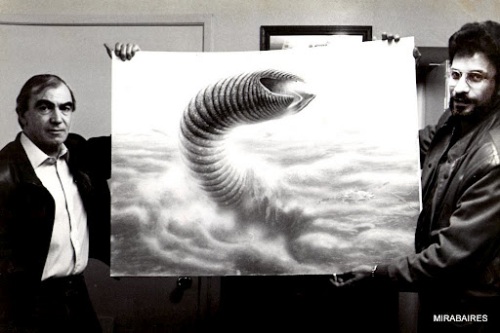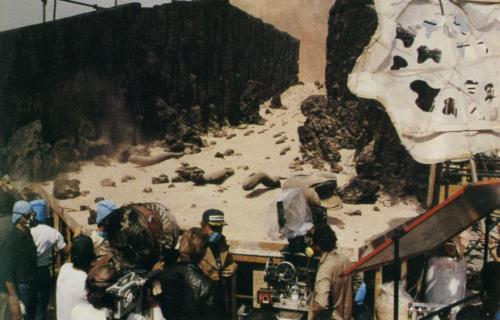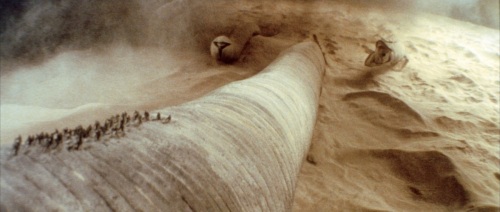Static electricity is IGNITING in the air and the sand is swirling around the harvester. Then they see it. A wide hole emerges from the sand, glistening spokes within it. The hole is twice the size of the harvester. Suddenly the machine turns and slides into the hole, parts of it EXPLODING. The SOUND is deafening.
This is what Paul Atreides witnesses in his first ‘close encounter’ with a Sandworm, in David Lynch’s final script for the 1984 film adaptation of Dune. In the universe of Frank Herbert’s eponymous novel series, the Sandworms are the titanic inhabitants of the desert planet Arrakis. Their name among the Fremen is Shai-Hulud, a term actually derived from Arabic, and literally translatable as ‘eternal thing’. In the Fremen language, however, the term can have different meaning, depending on the size of the worm itself. ‘Old Man of the Desert’, ‘Grandfather of the Desert’ and ‘Old Father Eternity’ are among the known translations. The term also alludes to the Fremen belief that the Sandworms and their actions are embodiments of God.

The Shai-Hulud begin their life as microscopic larvae, called Sand Plankton, which eventually grow to the stage of Sandtrout (or Little Makers, as labeled by the Fremen) — “flat and leathery” creatures, with no recognizable features besides their external ciliae. Their purpose is to block water in fertile pockets underground, in order to create a safe habitat outside for the bigger worms. It is in this stage that the creatures excrete a substance that, combined with water, produces pre-spice mass — which, in turn, transforms into spice when it surfaces. The Sandtrout enter hibernation and eventually reach the “stunted worm” stage (about nine meters in length), only to become the fully-grown Shai-Hulud, which can grow over 400 meters of length for 40 meters of diameter. The worm Paul Atreides summons, however, “appeared to be around half a league” in length, indicating that the creatures can reach much bigger sizes.
Herbert described the Sandworms as very similar to Annelids: they are cylindrical creatures with circular mouths, equipped with rows of crystalline teeth. Paul Atreides described the mouth as “some eighty meters in diameter… crystal teeth with the curved shape of crysknives glinting around the rim… the bellows breath of cinnamon, subtle aldehydes… acids.”

An initial attempt at designing the Sandworms for a film was done by Hans Ruedi Giger, for Alejandro Jodorowsky’s Dune. Giger’s design bore the artist’s trademark biomechanical textures and sexual overtones. When Jodorowsky’s Dune was abandoned, so was Giger’s Sandworm — never to be presented onscreen.
The design process for Lynch’s Sandworms began with illustrations by Anthony Masters and Ron Miller. The first element to be established was the creatures’ colour scheme. Miller told Cinefex: “Boy, did we go round and round on those! David had come across a photograph of a piebald elephant trunk — a sort of mottled red and black — that he liked very much. So that was the coloration he decided on for the worms. That decision was made fairly early on and adhered to throughout the production, even though when you see the worms in the film, they’ve been so covered by dust and sand that they look more gray than anything else, but the overall shape of the worms, particularly the mouths, wasn’t as easy to nail down.”

Masters’ earliest concepts for the Sandworms were considerably similar to John Schoenherr’s illustrations for the novel series — in particular, they sported a three-lobed mouth. A considerable number of iterations was considered. “The worms went through a lot of changes,” Miller recalled, “mostly having to do with varying their degree of obsceneness. After all, we were all more than well aware of the fact that we were dealing with the greatest phallic symbols in the universe, and that we would have to be very careful about our worm designs and the camera angles we would use to shoot them. Eventually, though, the worms came around full circle, right back to the drawings Tony had done that looked like Schoenherr’s. And I was happy, I liked that three-lobed mouth and argued for it a long time.” The three-lobed mouth also served the purpose of making the worms appear always upright, even when they ‘rotated’.

Veteran Italian Monster Maker Carlo Rambaldi and his crew were hired to bring the colossal Worms of Arrakis to the screen. Given the actual importance of the creatures in the film, and the fact that they should be absolutely convincing onscreen, they were given top priority among the creature effects of the film — with over 24 machinists, moldmakers and sculptors working on this task. Rambaldi actually added to the worm design the inner mouth, with three lobes corresponding to the external lobes — filled with crystalline, needle-shaped teeth. This innovation was not only judged to be visually dramatic — but was also designed for a biological purpose: with the inner lips, the worms could avoid accidental ingestion of the sand they move around in.
In conceiving the design of the Sandworms, Rambaldi and his crew performed in-depth research on the appearance and behaviour of actual worms. Miller recalled: “I remember how, one day, Carlo and an assistant dumped a carton full of earthworms on David’s desk while we were still working in L.A.. Here’s Tony and Carlo standing around while David’s hunched over a worm, staring at it through a magnifying glass and saying, ‘where’s it’s mouth?’ David couldn’t find it. Later, he looked up, smiled and said: ‘I think this one is tired. Let’s get another.'”

A total of 15 full miniature Sandworms were built in various scales, depending on their purpose in specific shots. The worms were first sculpted in clay, moulded in plaster, packed in polyfoam and covered in latex rubber skin. Two models were fully articulated — with mechanized outer and inner mouths — and measured 22 feet of length for three feet of diameter. Those were used throughout shooting for sequences that required detailed foreground action (for example when Paul and Jessica hide in a rock formation and are attacked). Three worms were instead built in a smaller size — 15 feet of length for two of diameter — and could only move their body. One of those worms — mounted on the end of a rod — also served to portray a Sandworm diving in the sand. The articulated worms were controlled by inner mechanisms designed by Rambaldi and his principal machinist, Steve Townsend. They allowed a wide range of cable-controlled movements. 10 stunt worms — nicknamed ‘sausage worms’ by the crew — were also built, devoid of any articulation and guided with tracks buried in the miniature desert sets, and simply pulled with cables.

For close-ups of the Shai-Hulud, two worm sections were constructed. The main close-up head and neck section was 12 feet long for five feet of diameter. “[It] was so big it could easily swallow a human head,” Rambaldi recalled. “In fact, that’s mainly what we used this section for — swallowing. It had a heavily detailed outer mouth and an inner mouth lined with teeth, and we used it for many closeups — like swallowing the harvester, the camera, and the Sardaukar army at the end of the picture.” The other model was a tail section, measuring 20 feet of length for three feet of diameter.
Accompanying the Sandworms were their riders — obviously built in scale as rubber miniatures of three different sizes. The most detailed were given maker hooks and lines, although the majority was simply humanoid in shape. The only full-size worm built for the film was featured in a deleted scene of the film: it was a ‘stunted’ worm, in a scene where it is drowned by the Fremen to obtain “the water of life.” The fully articulated worm featured a more varied color scheme indicating its younger age.
The sequences involving the worms — a total of 125 shots — were mostly filmed indoors on a massive ‘worm set’ constructed on Churubusco’s Stage 4. Semicircle-shaped and filled with “five truckloads of sand,” it was 100 feet wide, 60 feet deep and built over platforms five feet off the floor; it was also built in sections that could be detached and reassembled, depending on what specific shots requested. Behind the tabletop a thirty-foot tall sky cyclorama, painted by Ted Mitchell (and repainted about four times), was positioned. In certain shots, such as those from the final battle, additional optically-introduced dust, as well as lightning (provided by the Van der Veer animation department), was added.

Puppeteering the Shai-Hulud was a task assigned to Rambaldi and a crew of 60 ‘worm handlers’ — all hired locally in Mexico city; their only prerequisite was that they should be able to speak either English or Italian. The tracks on which the worms were mounted were shaped like sine waves, to give the worms “their desired wiggling motion.” Rambaldi recalled the puppeteering process: “to operate three different worms at the same time, it took nine people at the worm controls. But to operate the largest worms, it took 18 people. Most of the worms were connected on the bottoms of their bodies to three or four different points on the tracks. When we first started to film the worms, security was very tight and people had to wear ID badges just to get on the stage. Even so, things could get crowded in there. Both Brian Smithies and Barry Nolan had a crew of 35 people, and my crew was on stage all the time. But things were funny, too. There were a lot of signs around, painted in Spanish, that said ‘don’t step there!’ or ‘no photos!’ And one of Nolan’s people made this big hand fan out of white cloth to wave Kit West’s smoke around — the kind of fan you see slaves waving over the pharaoh in movies. But this one had ‘Eat at Joe’s’ painted on it!” The ‘smoke’ was a mixture obtained by West to accomplish the black smoke requested by Lynch and moved on set with a wind machine.

In order to enhance the sense of mass of the worms, the creatures were filmed in high speed with increased frames per second — from 120 to 240, depending on the shot — making their movements slower and more appropriate for animals of such sizes. The only actual issue would be finding a material to simulate sand, as actual sand would be too big against the miniature creatures. Kit West, part of the crew, recalled: “when we were trying to plot out the best way to give absolute realism to our worms, shooting them at high speeds seemed an obvious part of the solution. High speeds would give them a sense of scale and bulk. But what about the sand on the desert around them? I knew right away that we were going to have trouble using regular sand because the grains would be too big against the worms, and David really wanted these worms to flow through the sand, to look like they were swimming through water. So, instead of sand, we used a mixture of fuller’s earth and microballoons. We used tons of fuller’s earth on this film, not only on the miniature desert shots — but to blow around in the air to simulate dust storms on the live-action sets as well. Fuller’s earth is a very, very fine powder, like talc, that is actually mined. It has a slightly brownish tinge and no small; it’s not dangerous to the eyes; and it won’t even really hurt you if you swallow mouthfuls of it. All we did was lighten or darken it slightly, by putting a tint of color to match whatever background we had.”
Whereas the fuller’s earth was not dangerous, the microballoons were — and the crew had to wear protections when filming with it. West continues: “along with the fuller’s earth, we used 5000 pounds of microballoons on the worm set. Microballoons themselves are incredibly small, hollow spheres of borosilicate glass that are about 2.5 thousandths of an inch or 60 microns across. The microballoons worked very well. They were so small in relation to the worms that they flowed like water off them. But microballoons aren’t as safe as fuller’s earth. In fact, the damn things are very dangerous; once they get in your lungs they stay there. So all od us on the worm set always had to wear face masks to filter out the air.”

Most worm shots appeared in the final film without additional post-production additions. Others were used as plates or bluescreen elements for composite shots. The most challenging ones were the ones where the Fremen are seen running alongside the worms. Nolan explained: “for scenes where people are seen running alongside the worms, we did a lot of very long shots of real people running out in the Samalayuca desert. Then we matted them in with our miniature worms. In one scene, where a worm pushes sand over the Sardaukar troops, we just piled some sand and microballoons on the edge of a big horizontal blue screen, and then had a worm enter the frame and push it down onto the screen. We matted that into a live-action plate shot from an 80 feet tall platform we’d erected on the back lot for POV shots of the worm riders. We had to build that tower — a tubular steel structure — around a tree, of all things, because it was the only location we could use to get that height. We didn’t want to cut the tree down, so we just built around it. It was like the biggest treehouse in the world.”

Specific shots of the Shai-Hulud were filmed elsewhere: the sequence where a Sandworm swallows the spice harvester whole was filmed in a park lot. For the scene, one of the small worms was first used to portray the creature approaching the harvester. When the machine is finally devoured, a miniature built in beeswax was used in combination with Rambaldi’s close-up worm head — filmed in a specifically built set. Modelmaker Danielle Verse explained: “it was only a big platform, really, about 20 feet high and 12 feet across — with a hole in the center for the worm. First, we covered that hole with sand and put our little harvester on it. Peter Bohanna and I were up above, using a fan and some fuller’s earth to kick the sand around a little. Then, underneath, Carlo’s crew had the worm head attached to a counterweight and running on a steel track. They dropped the weight, the head pushed up through the hole and then its mouth closed around the model.”
One of the most important sequences was the iconic Sandworm riding test. “I knew the worm ride was one of the little hearts of the book,” Lynch said, “and I knew we’d better come up with something good for the film, or we’d be in big trouble.” Shots of live action were combined with one of the large worm models, as well as the close-up head, filmed at 240 frames per second in the worm set. The final shot, with the Sandworm roaring, was a composite featuring the close-up head, a bluescreen foreground shot of Kyle MacLachan, and one of the large worm models in the background. A similar set-up was used in another shot, with more Fremen added.

Life-size worm hide sections were also built for certain shots, such as when Paul uses the maker hooks; the hide section was 50 feet long and 18 feet tall and constructed out of wood and rubber. It was hung on a tubular steel framework equipped with 10 axles and 20 wheels, which was in turn mounted on a 200-foot track. When Paul actually plunges his maker hook into the worm’s skin, he exposes an inner section. It was achieved with latex and gelatin, and detailed with “hundreds of condoms” (cut lengthwise and with their tip removed), all applied by hand. To achieve the worm’s rotation, Maclachan was filmed whilst on a worm skin section against a bluescreen, with the camera moving down towards the stationary actor. Another ‘back’ section was built for the scenes where the Fremen are shown riding the worms. It was 40 feet square and constructed in wood, sponge rubber, and hand-painted latex for the worm’s skin. The final addition was represented by four blowholes, used by the worm to expel accidentally ingested sand. Each blowhole featured a pneumatic compressor tube, “one end of which let to a hopper filled with fine sand,” said West, “and the other terminating in a ring device, which opened and closed off the tubes. The rings were further overlaid with latex. On cue, the latex pulled back, the tubes opened, and air pressure blew out a shower of sand particles.”
Frank Herbert was overall satisfied with the Sandworms and the other elements of the film adaptation. “No matter what happens ultimately to the film,” he said. “David and Raffaella [De Laurentiis] and everyone else who worked on this picture really have given it their best shot. They have nothing to be ashamed of, and I’m totally satisfied. They’ve made the real Dune.”

For more images of the Sandworms, visit the Monster Gallery.





Alla mostra dedicata a Rambaldi che vidi da piccolo a Cinecittà c’erano proprio un paio di modelli di questi “vermoni”.Bellissimo quel concept fatto da Rambaldi….
Dune, the movie where the villains never stood a chance.
[…] Following Rex was a small section entirely dedicated to David Lynch’s Dune, ending the main exhibit on a high note. As a long-time enthusiast of the film and its creatures, this was the real showstopper for me. Projected set photos from Dune and other films (among which King Kong, Conan the Destroyer and White Buffalo) were surrounded by one of the small-scale Guild Navigator puppets, two hero Sandworms, and a number of stunt Sandworms. […]